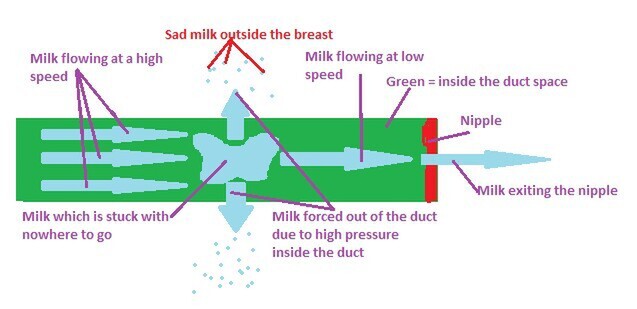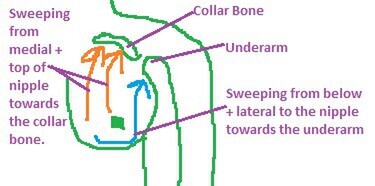Let me begin by introducing myself …. My name is Lara and I treat inflammatory conditions of the lactating breast (what a mouth full right!?, let’s call it ICLB for short). ICLB AKA mastitis AKA blocked ducts is a condition where milk is forced from inside the milk duct, to outside the duct and into the surrounding tissue. When milk goes rogue like this it creates inflammation and occasionally this can also lead to infection. Let’s break it down:
Milk INSIDE the duct = happy boobs
Milk OUTSIDE the duct = sad boobs
So how do we get ICLB?
1st Option: ‘A Mechanical Block’. Think tight bras, infant squeezing breast hard, using a pump with improperly fitted flanges* or nipple trauma causing blockage at the duct’s exit point. Below is your first diagram of the day … if you have read my first blog, you’ll know art is not my forte, but I’ll force them on you just the same!
Artwork 1 of the 2020 Happy Boob Series:
Sad Boobs from Rogue Milk
* if you intend on using a pump, please get the flanges fitted properly. They come in different sizes.
‘A Traffic Jam’. When the infant latches, it initially sucks very hard. Despite its best efforts, babies do not receive milk instantly as it takes time to travel from the back of the breast (where milk is made), to the nipple.
This form of ICLB/mastitis is particularly common in the first 6 weeks postpartum when your body is trying to to do this new thing called breastfeeding. This breastfeeding thing means your boobs need to work out: how much milk baby needs/how frequently baby wants to be fed/what milk recipe needs to be used etc. And TBH, that’s a big job and there is sometimes teething issues early on.
Once the milk does reach the nipple though, it rushes into the baby’s mouth at a super speed high rate. Which makes sense, because the baby was sucking at this super speed high rate. Our problem arises though when baby works out it can’t swallow and suck at this same crazy high speed. So it stops sucking so hard.
Which would be fine, except we already have high flow milk on the way BUT it’s now not being cleared at this same high-flow rate. So in effect what we get is … a milk duct traffic jam. A high pressure results from this within the duct, leading to milk being forced outside of the duct. You end up with … ICLB AKA mastitis AKA sad boobs.
Again, a diagrammatic masterpiece to refer to:
Artwork 2 of the 2020 Happy Boob Series:
A Milk Duct Traffic Jam
And sometimes, more annoyingly, we just don’t dang well know what causes it. Times to be careful with though are: when you/bub have a cold, the weather changes, you begin to wean, you return to exercise (sports bras!), return to work, go out for the first time in 12 months and throw that fancy bra on again … pull a face and the wind changes direction?
So how do I know if I have the dreaded ICLB?
- Pain in the breast (which could extend up to the collar bone and wide to the underarm).
- Breast redness
- Breast heat
- Breast firmness/lump/feels tight/feels blocked/there’s swelling/feels grainier all of a sudden (just different to how is usually feels?).
- Reduced supply on effected side.
- Fever
- Generally feeling unwell/nauseas/headaches/low energy
If you do experience any of the above, please let your midwife/lactation consultant/mastitis treating physio/women’s health GP know ASAP (this list for simplicity now referred to as your ‘dream team’ … a technical title). ICLB can progress pronto pronto, so therapists who are comfortable treating it will get you in ASAP. We’ll make appointments “appear from thin air”. Magic … I know.
So … after reading all of this you find yourself looking down at the girls and going … lefty is dang sore, red and I haven’t got as much milk from her as I usually would; it’s time to see someone from the dream team.
A step by step guide to getting help/helping yourself if you suspect ICLB:
Step 1: Book an appointment online with one of the dream team. (N.B. even if you can’t see appointments online, remember these appointments appear from nowhere, so call first thing in the morning, try a Facebook message, send a carrier pigeon, whatever you need to do).
If you are becoming VERY unwell, with symptoms outside the breast and symptoms making you distressed e.g high fevers, dramatic vomiting, PLEASE GO TO THE HOSPITAL!
Step 2: Continue feeding your baby on your effected side. Sorry, this is not a cruel joke. If your issue is more an engorgement/small blockage, this can be enough to clear it of itself. If you are more comfortable hand expressing, by all means, give this a go. Hand expressing should not be painful, you should use light pressure, and should use the flats of your fingers, not the tips.
Step 3: Use a warm pack, take ibuprofen and/or panadol if you feel like it.
Step 4: Remove anything digging into the breast, e.g. bras, tight clothing with strong seams etc.
Step 5: FOR THE LOVE OF ALL THINGS PINOT NOIR, do NOT jab yourself in the boob with pokey massage!
The ductal tissue is very delicate. Firm massage damages the ducts easily and creates a bigger problem.
But every man and his dog tells you to massage your breast when you have mastitis right? So what’s a girl to do?
Use the flat of your hand/finger tips to sweep from below/lateral side of the nipple, up towards the arm pit. We then repeat this on the top/medial side of the nipple and sweep towards the collar bone.
Artwork 3 of the 2020 Happy Boob Series:
“I solemnly swear to use a flat hand only to massage my breast. I sweep towards my lymph nodes.”
Please do not experiment with pumps for the first time if you think you have mastitis. They can be difficult to use at the best of times and if an incorrect flange size is used, can make new blockages/exacerbate your condition. Bub is enough drainage.
All I would like to finish with is … I am pro-breast feeding of course! And I will do everything I can to make your breastfeeding journey as easy/comfortable/enjoyable as possible. I am never however, going to judge anyone’s decision to breast/bottle feed, to wean ‘early’ (whatever ‘early’ is?), encourage you to “try just one more time”, insert other ridiculous statements women are told. There is well enough pressures in this world (and especially in the pregnancy/birth/postpartum space) without adding a judgey health professional to this list!
So … may the force be with you new mothers, we are your people, we are here to help if you need us.



